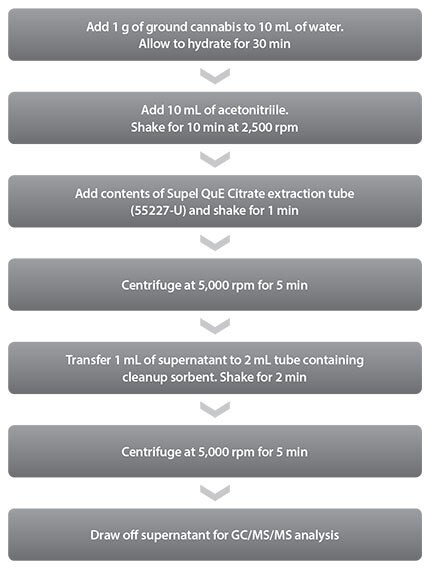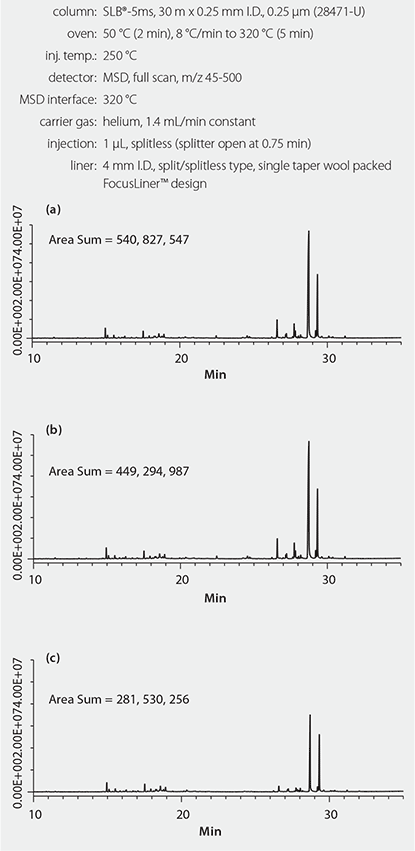Analysis of Pesticide Residues in Cannabis Using QuEChERS Extraction and Cleanup Followed by GC/MS/MS Analysis
Kathy Stenerson, Michael Halpenny
Reporter US Volume 34.1
Cannabis (marijuana) has been legalized for recreational and/or medical use by 23 states, the District of Columbia, and the territory of Guam. Thus, regulations regarding its production have become a topic of interest. The use of pesticides on cannabis is currently not regulated by the US EPA due to its listing as a Schedule 1 narcotic by the federal government. States that allow cannabis use for recreational and/or medical use have differing regulations regarding pesticides. As indicated in Table 1, the scope of regulation varies widely; from regulations on use, testing, and labeling, to no regulation at all.1
There are no official test methods for the determination of pesticide residues in cannabis. However, a potential approach is the use of the “quick, easy, cheap, effective, rugged and safe” (QuEChERS) method outlined in AOAC official method 2007.01. In this application, QuEChERS was used in the extraction of pesticides from dried cannabis. The pesticides studied were selected from lists currently tested by several commercial cannabis testing laboratories. The list included triazole fungicides as well as organophosphorus, organochlorine, and pyrethroid insecticides. Also included was piperonyl butoxide, a pesticide synergist included on the state of Colorado’s list of “pesticides for use in marijuana production”.2
For cleanup of the extracts, two different sorbent mixes were evaluated: (1) PSA/C18/ENVI-Carb™ and (2) Supel™ QuE Verde. The first represents a conventional mix often described as “PSA/C18/ GCB” in QuEChERS protocols. PSA removes acidic interferences, while C18 retains hydrophobic interferences. Graphitized carbon blank (GCB or ENVI-Carb in this application) will retain chlorophyll and other colored compounds. However, while effective in removing pigment, GCB also retains target compounds with planar structures. Thus, pesticides with planar structures can be retained, reducing their recoveries. The second sorbent, Supel QuE Verde, contains a mixture of PSA, Z-Sep+ and an improved GCB. Z-Sep+ is a silica that is functionalized with both zirconia and C18. Zirconia will retain some fats and carotenoids, while C18 retains hydrophobic interferences. The improved GCB used in the Supel QuE Verde mix has been optimized to balance chlorophyll removal and improved recoveries of planar pesticides. When used to clean samples containing chlorophyll, this sorbent blend will provide better recovery of planar pesticides than sorbents containing traditional GCB.

Figure 1.Sample Preparation for Extraction of Pesticides from Cannabis
Experimental
Dried cannabis was supplied courtesy of Dr. Hari H. Singh, Program Director at the Chemistry & Physiological Systems Research Branch of the National Institute on Drug Abuse at the National Institute of Health. The sample was ground to a fine powder and extracted following the procedure outlined in Figure 1. The resulting acetonitrile extract was cleaned using two different sorbents: (1) PSA/C18/ENVI-Carb and (2) Supel QuE Verde. Unspiked and spiked (50 ng/g) samples were prepared. Analysis of the final extracts was done by GC/MS/MS using the GC conditions listed in Figure 3 and MRMs in Table 2. Quantitation was performed against multi-point, matrix-matched calibration curves prepared in unspiked cannabis extract. Separate curves were prepared for each cleanup sorbent.
Results and Discussion
Background
Figure 2 shows cannabis extracts before and after each cleanup. As expected, the PSA/C18/ENVI-Carb sorbent mixture removed the most color. The Supel QuE Verde mix removed the green from the cannabis extract, leaving only yellow pigments, and a much lighter colored extract than no cleanup. Extracts were analyzed by GC/MS in full scan mode to evaluate background (Figures 3 a-c). The TIC patterns of the extracts, cleaned and un-cleaned, appear similar. However, the amplitude and area sum of the peaks was the lowest after cleanup with Supel QuE Verde.

Figure 2. QuEChERS Extracts of Cannabis With and Without Cleanup

Figure 3.GC/MS Scan Analysis of Cannabis Extract Background (a) with no cleanup, (b) after cleanup with Supel QuE PSA/C18/ENVI-Carb, and (c) after cleanup with Supel QuE Verde
Recovery and Reproducibility
The average recoveries obtained from 50 ng/g spiked cannabis samples are summarized in Table 3. Recoveries were generally better using the Supel QuE Verde cleanup for many of the pesticides, especially the pyrethroid pesticides and triazole fungicides. The organophosphorus pesticides showed mixed results, with some such as chloropyrifos showing better recovery from Supel QuE Verde, and others such as phosmet showing better recovery using PSA/C18/ENVI-Carb. Quinoxyfen (highlighted in yellow in Table 3) showed very poor recovery after cleanup with PSA/C18/ENVI-Carb. This compound has some planar character to its structure, which resulted in strong retention on the ENVI-Carb, and thus reduced recovery. The pesticide synergist piperonyl butoxide, of interest in relation to cannabis production, showed >70% recovery using both cleanups, but better recovery after Supel QuE Verde compared to PSA/C18/ENVI-Carb cleanup. Reproducibility, determined as % RSD for n=3 spiked replicates, was generally very good for both cleanups. The exceptions were tetramethrin and cypermethrin, which had RSD values >20% after PSA/C18/ENVI-Carb cleanup.
Conclusions
As demonstrated here, QuEChERS is a viable approach for the analysis of pesticide residues in cannabis. Many compounds of interest, including piperonyl butoxide, show good recovery and reproducibility by this extraction technique. For cleanup of QuEChERS extracts of cannabis, the use of graphitized carbon is recommended for removal of chlorophyll. However, as evidence by the recovery of quinoxyfen in Table 3, traditional GCBs such as ENVI-Carb will reduce the recovery of pesticides with planar structures. Supel QuE Verde, which contains PSA, Z-Sep+ and an improved GCB, can be used to reduce pigmentation while improving recoveries of these compounds.
Compared to conventional PSA/C18/GCB cleanup, cannabis extracts cleaned with the Supel QuE Verde mixture showed lower GC/MS background, and better recoveries for many pesticides.
References
To continue reading please sign in or create an account.
Don't Have An Account?